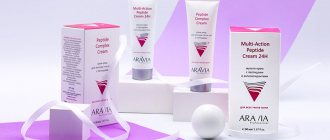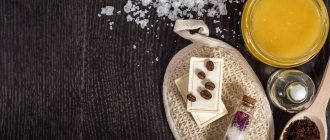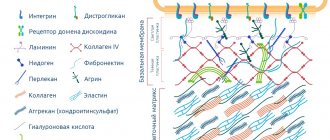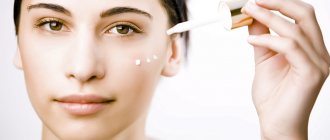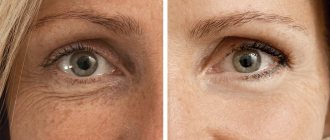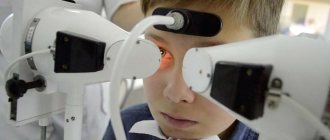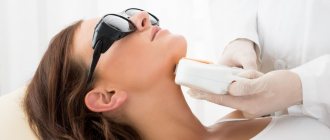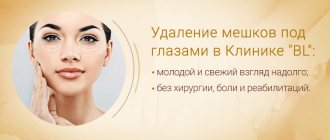Today, bioregulators, which are based on stable amino acid compounds, are the basis for the production of food additives, medicines, cosmetics, and special injections. Geroprotectors for skin rejuvenation, which contain peptides, are not a fiction at all, but a long-existing reality. Peptides offer people not only health and longevity, but also beauty. To talk about this issue, we invited Natalya Simonova, a cosmetologist and dermatologist who practices modern drugs as means for skin rejuvenation, to our office.
Geroprotectors for skin rejuvenation
Natalya Simonova told us that peptides are recognized as the most popular components of medical and cosmetic preparations. Geroprotectors for skin rejuvenation are preparations that in most cases consist of a peptide base. After all, peptides are not just substances invented for marketing purposes, but powerful regulators of such processes as:
- Wound healing.
- Restoration of the natural functions of organs and tissues.
- Cell rejuvenation.
The use of peptides in cosmetic preparations for home care and in clinical products, including mesotherapy procedures, has long been commonplace.
After all, peptides are real geroprotectors for skin rejuvenation.
The battlefield is the extracellular matrix.
Let's get acquainted with the extracellular matrix, this is important for understanding the principle of action of peptide cosmetics. The definition of matrix is given in an extremely simplified manner and in the context of this article. In fact, the matrix occupies about 25% of the volume of our body, its structure and functionality are much, much, more complicated than described here.
The extracellular matrix is the skin framework consisting of elastin, collagen, and hyaluronic acid. The quality of this frame determines the quality of the skin - the absence of wrinkles on the face, firmness, elasticity. Creative and destructive processes are constantly going on in the matrix, that’s how it’s structured. The builders are fibroblasts, the destroyers are special enzymes - metalloproteinases. Fibroblasts produce collagen, enzymes destroy it, fibroblasts produce it, enzymes destroy it, etc.
Fibroblasts are connective tissue cells that synthesize collagen and elastin; the amount of collagen and elastin, and therefore the quality of the matrix, depends on their activity.
Metalloproteinases are enzymes that destroy old, broken matrix components, clearing the way for cells. Collagen fibers fall under their destructive effect.
Aging and the appearance of wrinkles are a deterioration of the matrix structure, so most of the effects of anti-aging cosmetics are aimed at improving this structure. But wrinkles are different, just like the types and types of aging. To learn how to choose the right anti-aging product, read the article - Remedies for facial wrinkles.
Having described an extremely simplified model of the matrix, life and death of collagen, we will continue to talk about peptide compounds.
Peptides - what is the peculiarity of their use?
Experts have long recognized the fact that peptide bioregulators that enter the body through the digestive tract or by injection are the most effective. This is why cosmetics containing amino acid chains are not as effective as injections and capsules for oral administration. What is the reason? The molecules of the active substance need to overcome many barriers on the way to the cell.
Why are peptides considered geroprotectors?
Peptides are parts of protein cells. They are the parts that are involved in the construction of proteins. Initially, peptides were obtained by isolating their animal fractions. This created difficulties for their use as ingredients in dosage forms. The thing is that the breakdown of proteins into peptides is a complex process, fraught with the preservation of a number of bio-impurities in the resulting substance that can cause allergic reactions.
The production of peptides today is a streamlined process controlled by high technology. Geroprotectors for rejuvenation in the form of peptides are small synthetic compounds. They penetrate tissues and systemically affect cells, regulating their functions or restoring impaired functions.
Various properties of peptides
A feature of the effect of peptides on the body is their selectivity. Today, more than 200 types of peptide compounds are known. And they all have different functions.
For example, a peptide bioregulator for the liver is useless for the prevention of bronchial diseases.
This is why there is a specialization of peptides even in cosmetology:
- From pigmentation.
- For weight loss purposes.
- Geroprotectors for rejuvenation.
- Smoothing wrinkles.
- Elimination of puffiness.
- Combating local fat deposits in individual parts of the body.
The use of peptides should be carried out under the supervision of specialists and with the use of testers in order to exclude the adverse effects of these substances, which may be caused by allergic reactions.
Not all peptides are geroprotectors
The effective use of peptides lies in the connection of these substances with precisely those receptors for which they are designed. Almost every cosmetic problem has its own set of preparations based on amino acid chains.
It is known that not all peptides are geroprotectors. This means that before using any drug, you must make sure that it is intended specifically for rejuvenation or preventing the development of aging processes.
Combination
Experts in the creation of peptide preparations for rejuvenation believe that the specific action of short peptides (when the current formula includes up to 4 amino acids) is at the cellular level. Any other drugs (such as vitamins, fruit acids, mineral serums) work at the tissue level. This is why the combination of retinol and peptides cannot cause any problems. But this does not negate the fact that it is better to use any pharmaceutical components under the supervision of a specialist.
About peptides in cosmetics
Peptides have been classified as geroprotectors for a long time. The thing is that these substances are constantly synthesized in the body. Their function is to regulate cell functioning.
- Unfortunately, largely due to the accumulation of toxins in the intercellular space, the amount of peptides produced by organisms decreases. Experts note a particular deficiency of necessary components in people over the age of 50.
- The noticeable effect of such a procedure as “mesotherapy”, if peptides are used in it, is explained by the active work not only of peptides, but also of additional ingredients such as hyaluronic acid. And peptides work unnoticed - it takes hours, days and even weeks to completely compensate for the deficiency and achieve a noticeable effect.
Peptides for rejuvenation: ready-made courses
After reading the basic information on peptides for rejuvenation, most likely many will ask the question: where to start taking it? Especially for such people, we have prepared ready-made courses of peptides for rejuvenating the body. Now you don’t need to rack your brain about what exactly is best to buy, how to take it, whether certain drugs are combined. Ready-made kits, depending on goals and means, will be presented on our website!
Peptidz.ru is the official website of the Khavinson peptide dealership. From us you can buy original Peptides products. There are quality certificates for each item. Delivery is valid throughout Russia. For clients from Moscow, there is pick-up from the office or courier service.
Geroprotectors for rejuvenation - how they can be dangerous
To avoid changing a given peptide chain (with a specific sequence of amino acids) by its rearranged variation, scientists have developed several carriers - substances that perform the function of attaching peptides to themselves unchanged and then detaching them in the body.
One of the carriers in cosmetology is hyaluronic acid. It allows not only to deliver peptides to the skin, but also to ensure their gradual release over a certain period of time. Such peptide therapy for cosmetic purposes actually ensures a full course, similar to sanatorium treatment: the peptides are released from the carrier gradually, since hyaluronic acid takes a long time to break down.
Geroprotectors for rejuvenation in the form of peptides allow:
- They activate exactly the cells for which they are designed.
- Active cells begin to produce the substances they need on their own.
- Cells “heal” themselves.
These processes are clearly visible when using peptides in cosmetology. Skin cells treated with peptides produce their own collagen, which restores elasticity to the skin and creates a lifting effect.
Neuropeptides used today in cosmetics additionally have a relaxing effect on individual tense areas, which improves skin regeneration.
Peptide complexes provide:
- Antioxidant protection.
- Moisturizes the skin.
- Protect the epidermis from harmful environmental factors.
Understanding the processes that we describe and can even evaluate with our own eyes, having tried it on ourselves - for the skin, it is easy to imagine how peptides work when they get into the cells of organs and tissues.
Geroprotectors for rejuvenation are used today in almost all industries related to human health. This is precisely the proof of their effectiveness and high safety. It is only a matter of time before the general public adopts peptides. Substances discovered in the 70s of the last century have not only not lost their relevance over the past 50 years, but have also significantly improved, expanding the list and methods of delivery to the necessary places in the body.
Something special: how peptides prolong youth and where to find them
The issue of prolonging youth has been exciting the minds of mankind for thousands of years, and thanks to the achievements of modern science, we are somewhat closer to solving it.
One of the ways to combat biological aging of the skin and the body as a whole involves the use of small proteins - peptides, cytokines and growth factors. Svetlana Trofimova, Professor, Doctor of Medical Sciences, President of the Russian Society of Anti-Aging Medicine, Professor of the Department of Gerontology and Anti-aging Medicine of the Federal State Budgetary Educational Institution of Further Professional Education "Institute for Advanced Training of the Federal Medical-Biological Agency"
Andrey Alenichev, Candidate of Medical Sciences, dermatovenerologist, cosmetologist, director of the Clinical Institute of Aesthetic Medicine
Scientists have long come to the conclusion that aging is a genetically programmed process and begins at the cellular level. Even if you lead an ideal lifestyle - you eat right, live in the best environmental conditions, do not experience stress on a regular basis, move a lot and do not abuse ultraviolet radiation - sooner or later you will experience changes according to a given scenario. Cellular activity will slow down, metabolic processes will deteriorate, the composition and structure of the intercellular matrix will change, and the sensitivity of a number of receptors will decrease.
Why is this happening? In modern science, there are several theories of aging: telomeric, adaptation-regulatory, free radical theory, etc. One of the leading places today is occupied by the peptidergic theory of aging. Its main idea is that with age, the number of peptides that regulate metabolic processes and protein synthesis at the cellular level decreases. These processes occur in various organs and tissues of the body, including the skin. After 50 years, the total number of peptides in the human body decreases tenfold compared to 20 years of age. Meanwhile, peptides are involved in the regulation of many important functions, initiate repair and renewal mechanisms, and trigger a huge number of biochemical reactions. The introduction of peptides from the outside restores the protein production mechanism, delaying the period of biological aging. Therefore, now much attention is paid to the study and creation of medicines and cosmetic products based on regulatory peptides.
Small, but smart
From a chemical point of view, peptides are small protein fragments consisting of chains of amino acids. The different effects of peptides are associated with their structural features and individual set of amino acids. In fact, any protein, such as collagen or elastin, is a polypeptide, as it consists of a large number of such fragments. Peptides include cytokines, growth factors, and many other agents of protein nature. They help cells interact with each other at a distance, transmitting information through the intercellular substance. However, cosmetologists use the term “peptide” in a narrower sense and designate signal molecules that have very specific properties. “Let’s immediately agree on which peptides we are talking about,” suggests Svetlana Trofimova. — The market is now flooded with Chinese and Korean cosmetic products that claim to contain peptides. Whether she should be trusted is rather a rhetorical question. The results from using such drugs are questionable, and it’s good if they don’t cause harm. On the other hand, in Russia a group of peptide bioregulators has been developed, certified in the form of pharmacological drugs. They are included in the standards for the treatment of certain diseases and are recognized throughout the world as geroprotectors. 15-year clinical studies on humans have shown that these peptides reliably lead to a reduction in mortality due to the regulation of the immune and endocrine systems. For such peptides, their structure and mechanism of action have been well studied, the long-term consequences of use are known for certain, as well as their effect on the body and its individual systems, including the skin. In particular, it has been proven that the transdermal method of administering peptide bioregulators helps improve the structure of the skin and has a visible rejuvenating effect. Many years of experience in using our peptide bioregulators in clinical practice have shown the high biological activity of the drugs, as well as their complete safety. Today they are used in various fields of medicine, including dermatocosmetology. If we talk about the prospects for peptide therapy, they look promising, provided that we are talking about substances with a scientific evidence base. If you buy a cream of unknown origin in a nearby store, there can be no talk of any safety or effectiveness. So peptides are different from peptides.”
Spectrum of action
The choice of cosmetics based on peptide ingredients should be approached very carefully. For advertising purposes, a manufacturer can write whatever he wants on the packaging of a cream or serum. Therefore, you should look for links to scientific articles and research results on the substances included in the cosmetic product. Only after this can one judge whether the selected drug is useful and safe, and whether it has proven biological activity. “For me, as a practicing physician, the most familiar and understandable is the use of regulatory peptides in serums and other cosmetics,” notes Andrey Alenichev. — Over many years of using them, I see that they give good aesthetic results to our clients. For example, peptides with botulinum-like action perfectly prolong the effect, and in some cases replace injection botulinum therapy. There are peptide preparations that activate the synthesis of structural fibers of the dermis, normalize local skin immunity and help people with atopic dermatitis or acne. In general, cosmetics with peptides have proven themselves excellent as a means of maintaining youthful and beautiful skin. Quite often, peptide components can be found in injection procedures, for example, as part of biorevitalizants or mesotherapy preparations. They improve microcirculation, reduce the volume of subcutaneous fat, and trigger regeneration at the dermis level. We are talking about a very promising direction, because new peptides are constantly being discovered, their bioavailability is increasing, and technologies for production and delivery to cells are being improved. Consequently, the effectiveness of using peptides will only increase over time.”
Cytokines
Small peptide messenger molecules, cytokines, regulate complex interactions between cells and stimulate or inhibit cell growth. A number of cytokines direct tissue stem cells precisely to those places where there are some affected areas in order to patch them up as quickly as possible. But why are they attractive from a cosmetic point of view? “The use of cytokines in cosmetology is of great interest, but also some questions,” says Andrey Alenichev. “On the one hand, they are specific proteins with the help of which cells of the immune system and a number of other systems can exchange information with each other and coordinate actions. On the other hand, most cytokines have an inflammatory effect, which is rarely needed in cosmetology. Recently, scientific evidence has emerged on the participation of IL-1a in strengthening the epidermal barrier, maintaining photoprotection of the skin, and improving the quality of the dermis. Drugs are being developed to compensate for age-related deficiency of this interleukin. But how well it works is still difficult to say.”
Growth factors
In 1985, American biochemist Stanley Cohen and Italian neurobiologist Rita Levi-Montalcini received the Nobel Prize for the discovery of neural growth factor and the artificial reconstitution of epidermal growth factor. Cosmetics manufacturers instantly became interested in the new direction, and today these signaling molecules can be found in many anti-aging creams. Growth factors are designed to stimulate growth and determine the “specialization” of living cells. Their concentration in the human body varies greatly throughout life. The most growth factors are in the blood of infants, but after 25–30 years their amount begins to gradually decrease, causing a slowdown in cellular regeneration and the accumulation of damage, which ultimately leads to aging. When scientists began to study growth factors, it turned out that many of them also have a positive effect on skin cells. As you know, with age, fibroblast activity invariably decreases, which leads to loss of skin elasticity and the appearance of wrinkles. Growth factors help slow down the withering process and significantly increase the function of fibroblasts. However, when using them cosmetically, difficulties arise. The fact is that the molecules of growth factors are too large, which does not allow them to penetrate into the deeper layers of the skin. Today it is believed that when applied to the skin, they penetrate only into the stratum corneum, but at the same time trigger a cascade of signaling reactions, which leads to accelerated cellular regeneration and increased synthesis of basic structural proteins. “Many scientists question the idea that the use of growth factors in cosmetic products can give a positive aesthetic result,” says Svetlana Trofimova. “At least within the framework of evidence-based medicine, there are no large-scale studies that would confirm this possibility. There is in vitro experimental data that shows that growth factors actually work in cell cultures in the laboratory. However, it has not been clinically proven that they have the same good effect when administered transdermally. In addition, growth factors are short-lived molecules, that is, they quickly disintegrate, so they will be quite useless in the composition of the same cream. It’s easier to go the other way and use the appropriate signal peptide, which will trigger the synthesis of your own growth factors. For example, a synthetic pineal peptide regulates the production of extrapineal melatonin (our hormone of youth), which helps to increase the number of fibroblasts, and with them growth factors. Based on the results of using this peptide, an improvement in the structure of the skin, a significant increase in the hydration of the epidermis, and a reduction in the number and depth of wrinkles were registered. In addition, ultrasound showed an increase in the amount of collagen and elastin. And all this with transdermal application, that is, with surface application of the peptide. Thus, we can talk about slowing down aging at the skin level and having a visible aesthetic effect.” In addition to the cutaneous application of growth factors, injection administration is used in cosmetology. “The most detailed scientific studies have been carried out on biological growth factors obtained from the platelet-rich blood plasma of the patient himself,” explains Andrey Alenichev. — We are talking about the injection technique of PRP therapy (Platelet rich plasma). When introduced into the deep layers of the skin, platelets release growth factors in physiologically optimal proportions, which trigger active tissue repair processes. They, like rescuers, aim at the place where their help is needed. This method is used not only in cosmetology, but also in orthopedics, gynecology, dentistry, and surgery. It has scientifically proven effectiveness and safety. Further development of the PRP technique and injections of one’s own growth factors looks very promising from the point of view of tissue rejuvenation. Already, the Swiss biotechnology company RegenLab has created a drug called Cellular Matrix, which combines in a single sterile closed system a carefully calibrated combination of hyaluronic acid, obtained by microbiological fermentation, and the patient’s own platelet-rich plasma. Both components have proven themselves in cosmetology and enhance each other’s effects. The drug is prepared in front of the patient and provides a double effect - biological rejuvenation due to growth factors and intensive hydration of the skin. And in the foreseeable future, new, no less interesting developments in the field of regulation of youth and health at the cellular level await us!”

